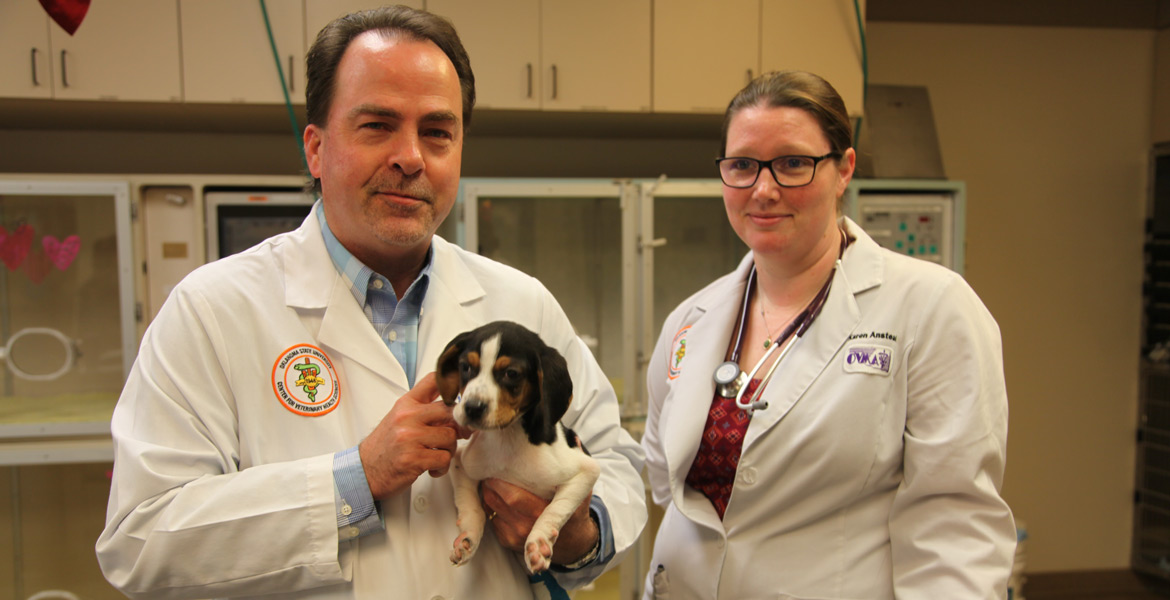
OSU's veterinary hospital treats puppy born with upside-down paws
Thursday, January 17, 2019
Having front paws that turned upward instead of down, Milo, a 5-week-old hound puppy, was surrendered to an animal rescue organization. Three weeks later, Milo arrived at Oklahoma State University’s Center for Veterinary Health Sciences. Dr. Erik Clary, associate professor of small animal surgery, at the Center’s Veterinary Medical Hospital, took the case.
“We evaluated Milo with our state-of-the-art CT scanner and identified his problem to be congenital dislocation of both elbows,” explained Clary. “With both elbows out of joint, Milo was unable to walk. Try as he may, the best he could do was an inefficient and seemingly uncomfortable ‘army crawl.’”
Milo’s condition is very rare. In 27 years of doing surgery, Dr. Clary says he has seen only three patients like this.
“It is very unusual, but also very debilitating. So when we do see it, something needs to be done.”
With the rescue agency covering the cost of surgery, Dr. Clary and his team performed corrective surgery on January 9, 2019.
“Milo’s surgery was complicated,” said Clary. “For each of his elbows, we had to go into the joint and restore the alignment. Then we placed a pin across the joint to keep it straight while his growing bones continue to take shape and his body lays down the internal scar tissue that will be needed for long-term stability. All in all, Milo was under anesthesia for about 3 to 3 ½ hours.”
When Milo woke up from anesthesia, he found himself in a rigid, front body splint.
“By design, the splint prevents Milo from using the front legs, and so his recovery is going to be a bit tough,” added Clary. “He will have to wear the splint for about three weeks. Then we’re going to remove it and take out the pins. The hope is that by that time his body will have done what it needs to do to keep the elbows stable.”
Once the pins are out and Milo’s elbows are judged stable, he will begin intensive rehabilitation therapy.
“We’re going to have to do some work to get some range of motion in his elbows and to teach him how to walk,” continued Clary. “It’s going to be a long haul. But if his elbows stay in place for the first three weeks after splint removal, he’s got a good chance of losing the army crawl and being able to walk as dogs should.”
Unsurprisingly, Milo has impacted people here at the Veterinary Medical Hospital.
Dr. Clary comments, “Milo’s a sweet and resilient dog. He quickly developed a real following in the hospital. Many a well-wisher checked in on his progress. And since he couldn’t ambulate or stand well with the splint in place, he was happy to find no shortage of student and staff volunteers willing to hold him and help him get outside when needed.”
If you would like to help pay for Milo’s veterinary medical care, please contact Oliver and Friends Farm Rescue and Sanctuary at 405-655-9885. Donations to the nonprofit organization located in Luther, Oklahoma, are tax deductible.
Stay tuned for more news as Milo travels the road to recovery.
MEDIA CONTACT: Taylor Bacon | Public Relations and Marketing Coordinator | 405-744-6728 | taylor.bacon@okstate.edu
